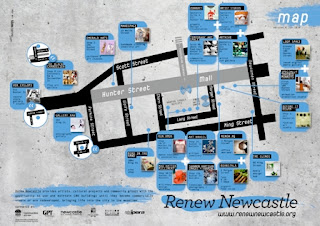 |
| (2010, British Council) |
Florida founded the Creative Cities concept on the assumption that in terms of city development and growth – work and livelihood would follow the Creative Class, growing up and expanding around an artistic hub. This idea opposes traditional understanding of the development of cities, where generally a population will grow in direct response to the available work in the area, where the paths and locations of people are drawn by work.
Florida’s Creative Cities theory is a problematic one, and has suffered not inconsiderable critique since its emergence. Many critiques describe Florida’s theories as elitist and exclusionary, and his data and statistic test have been questioned – according to Florida’s prerequisites, San Francisco has a very high creative city index due to the high percentage of gay population, yet the city performs more poorly in economic terms than various other, decidedly non-creative cities such as Houston.
Even though the idea of Creative Cities may be flawed, when pared down to its most basic it is essentially a passive approach to embracing creativity and community within the city, which has had some impact on design. Planners now consider not only the structure they are building, but also consider designing the community surrounding the structure and how interaction can be achieved. A great example of this is the Central Park project in Chippendale. This project is a designed ‘urban village’, encompassing structures for commercial and residential use surrounding a spacious park.
 |
| Conceptual draft for Central Park (2010, Fraser Property ) |
‘With 11 buildings, 1,800 apartments and a lively collection of shops, cafes, restaurants, laneways, terraces and offices, Central Park transforms the old Kent Brewery in Chippendale into an intelligent interplay of buildings and public spaces, and raises the benchmark for sustainable living globally.’ (Frasers Property, 2010)
 |
| Location of Central Park in downtown Sydney, Chippendale (2010Fraser Property ) |
Another example of the Creative Cities concept used in direct application to city infrastructure is the Renew Newcastle effort, which aims to utilize vacant space in the CBD district. After the closure of Newcastle’s BHP steel industry, the commercial centre of the city began to decline, leaving large amounts of empty space in the city. Renew Newcastle involves hiring out this free space inexpensively for creative endeavors, such as galleries and studios, which will encourage growth and repair in a deteriorating city.
 |
| Map of Renew Newcastle projects and sites (2010, Inventive Labs) |
 |
| (2010, Inventive Labs) |
REFERENCE LIST
2005, Florida, R., Cities and the Creative Class, Routledge, New York
11/10/2010, Florida, R., Creative Class: The Source on How We Live, Work and Play, The Creative Class Group, viewed on 2/9/2010, http://www.creativeclass.com/
2006, Florida, R., The Rise of the Creative Class, The Washington Monthly, Washington DC, viewed on 2/9/2010, http://www.washingtonmonthly.com/features/2001/0205.florida.html
4/1/2010, Macgillis, A., The Ruse of the Creative Class, The American Prospect Inc., viewed on 2/9/2010, http://www.prospect.org/cs/articles?article=the_ruse_of_the_creative_class
2010, Shaping Creative Cities in the UK and East Asia, British Council, viewed on 3/9/2010, http://www.creativecities.org.uk/tag/bangkok/
2010, Frasers Property, Central Park, Frost, viewed on 3/9/2010, http://www.centralparksydney.com/
2010, Reeders, N., Renew Newcastle, Inventive Labs, viewed on 3/9/2010, http://renewnewcastle.org/
No comments:
Post a Comment